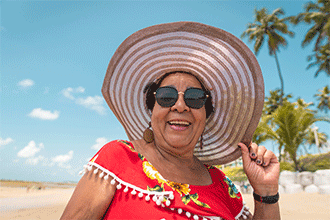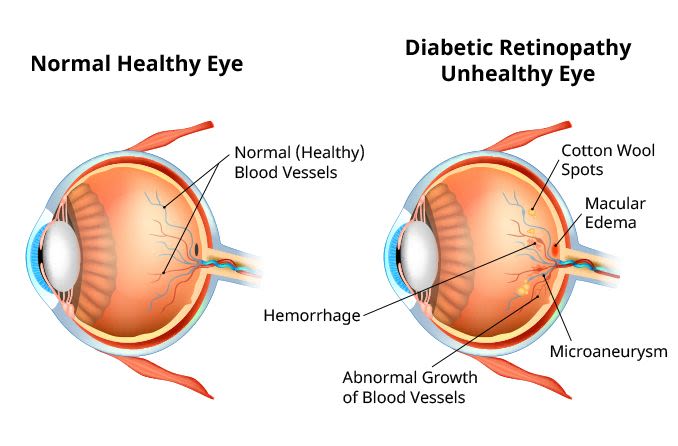In the past 20 years, studies focused on Latinos ages 40 and older have revealed an increased risk of developing eye disease such as diabetic retinopathy, cataracts, glaucoma and macular degeneration. These conditions can lead to decreased vision and blindness if those affected don’t get treatment.
Increasing access to eye care and awareness about eye health and common eye diseases can help lower the prevalence of these conditions in Latino communities.
Diabetic retinopathy
According to the Centers for Disease Control and Prevention, 68% of Hispanics and Latinos have poorly controlled high blood sugar. If high blood sugar continues to go uncontrolled, diabetic retinopathy can occur.
Diabetic retinopathy (DR) is a condition in which blood vessels in the retina begin to swell and leak blood into the eye’s vitreous humor (gel). Without treatment, DR can cause vision loss.
Statistics
Hispanics and Latinos are almost 2.5 times more likely to develop diabetes compared to non-Hispanic whites.
19% of surveyed Hispanics over age 75 had DR, whereas only 7% of African Americans and non-Hispanic whites were affected.
31.6% of Hispanic adults with diabetes have some level of visual impairment, compared to only 21.1% of non-Hispanic whites.
Diabetic retinopathy risk factors
Uncontrolled high blood sugar
Long-term diabetes (10+ years)
High blood pressure
Smoking
Pregnancy (gestational diabetes)
High cholesterol
Being Latino, Native American or African American
How to reduce your risk

Keep your blood sugar under control.
Maintain healthy cholesterol, blood pressure and weight.
Consume alcohol responsibly (no more than 14 alcoholic drinks per week).
Avoid or quit smoking.
Try to do around 150 minutes of moderate-intensity exercise each week (such as walking or biking).
Eat a balanced diet and cut back on the amount of fat, sugar and salt you consume.
Get a comprehensive eye exam regularly.
SEE RELATED: Diabetic Eye Exam: What to Expect
Cataracts
Cataracts are caused by a clouding of the eye’s natural lens. As you grow older, proteins in the lens begin to clump together. Over time, the protein clumps grow larger and can impair vision.
Usually cataract development isn’t noticed until after age 40. While both eyes are typically affected, it’s possible to get a cataract in only one eye.
Statistics
Cataracts are the leading cause of blindness in Hispanic communities, accounting for 42% of all vision loss.
61% of Hispanic Americans will have cataracts by age 80.
According to research done by the National Eye Institute, Hispanics are expected to have the most rapid increase in cataract prevalence between 2010 and 2050 — from 1.76 million cases to 9.51 million.
Cataract risk factors
Age
Family history
Accumulated sun damage caused by UV exposure, especially if work is primarily outside
High blood pressure
Previous eye injury or inflammation
Extended corticosteroid medication use
Previous eye surgery
How to reduce your risk

Wear sunglasses when outside or otherwise exposed to sunlight. Sunglasses should block 99% to 100% of UVA and UVB rays.
Avoid or quit smoking.
If you’re diabetic, work with a doctor or specialist to manage your diabetes.
Wear protective eyewear when playing sports or performing a high-risk activity, such as yardwork, welding or carpentry.
Practice good eye nutrition by adding more antioxidants to your diet, including lutein and zeaxanthin; carotenoids; and vitamins A, C and E.
Attend annual comprehensive eye exams.
Glaucoma
Glaucoma is a condition in which elevated pressure within the eye causes damage to the optic nerve. While there are several different types of glaucoma, the two most well known are open-angle glaucoma and angle-closure glaucoma.
Open-angle glaucoma is the most common form of the condition. Though non-Hispanic white women ages 70 to 79 currently make up the biggest demographic for the disease, studies project the largest demographic group will shift to Hispanic men by 2050.
Statistics
Eight of every 10 Hispanics/Latinos with glaucoma are unaware they have the condition.
76% of Hispanic Americans and Latinos do not know that their ethnicity is a risk factor for glaucoma.
According to a study on glaucoma prevalence in Mexico, the current number of Latinos with glaucoma is 854,000. It’s expected to rise to 1.06 million by 2030.
Open-angle glaucoma risk factors
Family history of glaucoma
Age 60 or older
High myopia (severe nearsightedness)
High blood pressure
Diabetes
Eye trauma or injury
Previous eye surgery
Prolonged corticosteroid use
How to reduce your risk

Quit or avoid smoking.
Limit caffeine intake, as high amounts of caffeine can increase eye pressure.
Maintain normal blood pressure levels.
Control medical conditions, such as diabetes, by eating a nutritious diet and exercising regularly.
Wear sunglasses and a hat when outdoors to protect your eyes from UV exposure.
Get regular comprehensive eye exams.
If you have one or more risk factors for open-angle glaucoma, your eye doctor may prescribe eye drops that could cut your risk of developing glaucoma in half.
SEE RELATED: What Are the Most Common Natural Remedies for Glaucoma?
Age-related macular degeneration
Age-related macular degeneration (AMD) is an eye disease that affects the macula — the central part of the retina that provides you with your sharpest vision, as well as color vision. Without the macula, your ability to read, drive, recognize faces and perform other visually detailed activities would be severely impaired.
There are two types of AMD — dry and wet — and dry AMD is the most common. According to the Los Angeles Latino Eye Study, early stages of AMD caused a lower health-related quality of life in Latinos than later stages of the disease.
Statistics
By the year 2050, the number of AMD cases in Hispanic communities is expected to be six times higher than what they were in 2010.
0.9% of Latinos and Hispanics over 50 have AMD, and 2% of Latinos and Hispanics have the condition by age 80.
AMD risk factors
Family history of macular degeneration
Age 75 or older
Having light-colored irises
Being female
Hyperopia (farsightedness)
Smoking
Accumulated eye damage caused by UV rays
High blood pressure
Poor diet
Inactivity
How to reduce your risk

Stop and avoid smoking.
Regulate blood pressure.
Maintain healthy eating habits and incorporate leafy green vegetables, fish, whole grain, and orange and yellow fruits.
Wear UV400 sunglasses when exposed to sunlight.
Exercise regularly.
See an eye doctor every year for a comprehensive eye exam.
Why Latinos are at a higher risk of eye disease
There are a few explanations for why Latinos are at a higher risk for developing eye disease, including lack of awareness, lack of access to health care and a variety of social factors.
Lack of awareness
A 2015 study for Transitions Optical found that only half of Hispanic Americans are aware that their ethnicity puts them at an increased risk of eye disease. And, as mentioned earlier, 80% of Hispanics and Latinos with glaucoma are unaware that they have it. This lack of awareness about the importance of eye health perpetuates the low number of Latinos attending eye exams and, in turn, the high rate of eye disease.
Lack of access to health care
Brookings conducted a survey that showed Latinos are three times more likely to be uninsured than their white and African American counterparts. While that number dropped from 40% in 2013 to 25% in 2018, one in four Latinos does not have health insurance.
Social factors
Social factors that affect eye disease include poverty and language barriers. Poverty can influence a person’s ability to seek help due to the costs associated with an eye exam and prescription lenses. Additionally, Latinos who are not fluent in English may feel intimidated by the language barrier between them and an eye doctor who does not speak Spanish.
Prevent and lower your eye disease risk
Some risk factors for eye disease are out of your control, such as your age and family history. However, there are steps you can take to minimize your risk. Incorporating these habits into your life can boost your eye health and reduce your chances of developing eye disease:
Have regular eye exams
According to Prevent Blindness, adults aged 40 to 64 should get a dilated eye exam every two to four years. Those aged 65 and older should do this every one to two years.
Regular eye exams make it possible for an eye doctor to spot warning signs of eye disease and start treatment before vision is damaged or lost. If a lack of vision insurance or the cost of an eye exam is preventing you from getting your eyes checked, there are public and private organizations that provide free eye exams and glasses for eligible people.
Protect your eyes from the sun
Damage caused by sun exposure is a contributing factor for many eye diseases. Wearing sunglasses whenever you’re in the sun can protect your eyes from harmful UV rays and potentially lower your risk of developing eye disease.
Stop smoking
Smoking negatively affects your health in many ways, including your eye health. In fact, smokers are four times more likely to have AMD and twice as likely to develop cataracts at an early age than non-smokers. Dropping the habit can help you save money, your health and your vision.
Practice a healthy lifestyle
A balanced diet and regular exercise are the building blocks of a healthy lifestyle. Incorporating nutritious foods into your diet — such as sweet potatoes, blueberries, spinach, salmon and almonds — will not only lower your eye disease risk, but improve your overall health.
Getting at least 150 minutes of moderate exercise every week offers similar benefits as eating healthy. Moderate exercise can include walking, riding a bike, swimming and working in the yard.
Don’t ignore vision changes or problems
Though it’s common to experience vision changes as you age, it’s important to have a doctor examine any changes you experience to make sure the cause isn’t dangerous. Sudden changes in vision, such as blurriness, dark spots or flashes of light, should be examined by an eye doctor quickly, as they could represent a vision-threatening condition.
READ NEXT: How Eye Disease Disproportionately Affects African Americans







